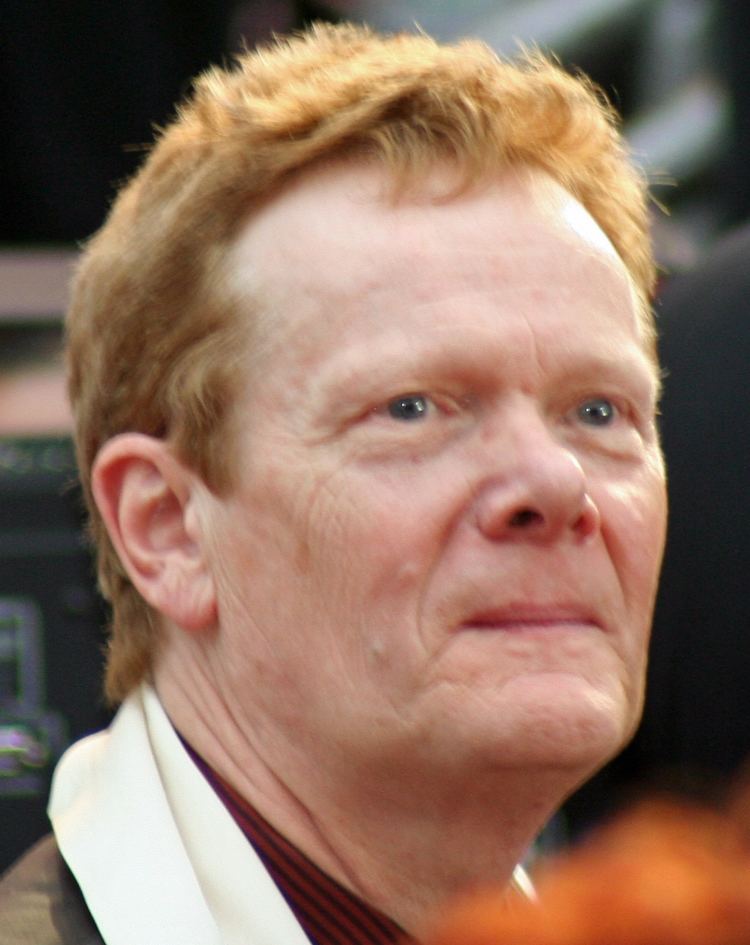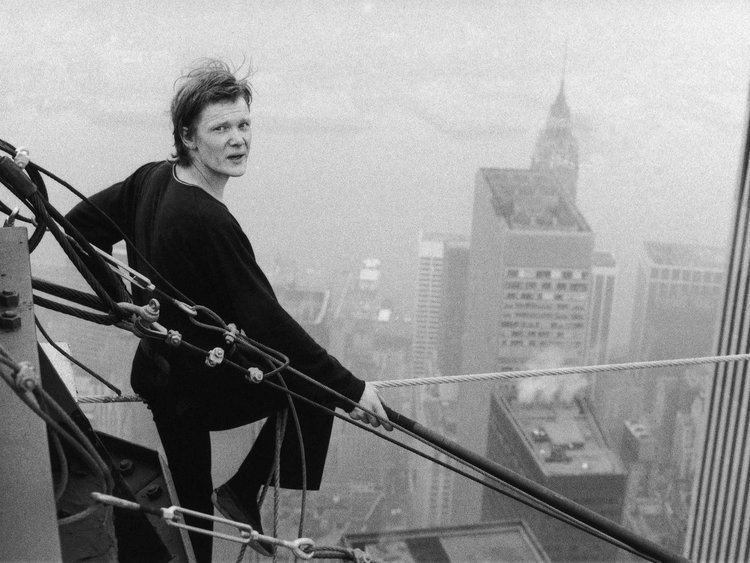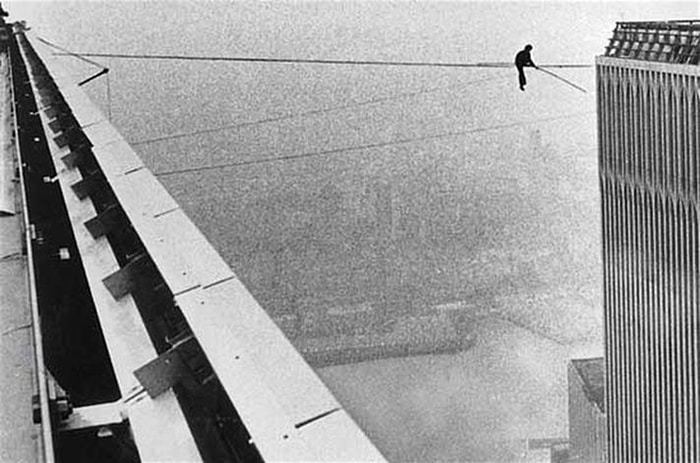Occupation High-wire artist Partner Kathy O'Donnell Height 1.70 m | Role Artist Name Philippe Petit Parents Edmond Petit | |
 | ||
Books To Reach the Clouds, On the High Wire Movies Man on Wire, Mondo, Niagara: Miracles - Myths an, One Armed Man Similar People Robert Zemeckis, Joseph Gordon‑Levitt, Charlotte Le Bon, James Marsh, Simon Chinn Profiles | ||
The art of balance with philippe petit
Philippe Petit ([filip pəti]; born 13 August 1949) is a French high-wire artist who gained fame for his high-wire walk between the Twin Towers of the World Trade Center in New York City, on the morning of August 7, 1974. For his unauthorized feat 1,350 feet (400 metres) above the ground – which he referred to as "le coup" – he rigged a 450-pound (200-kilogram) cable and used a custom-made 26-foot (8-metre) long, 55-pound (25-kilogram) balancing pole. He performed for 45 minutes, making eight passes along the wire. The following week, he celebrated his 25th birthday. All charges were dismissed in exchange for him doing a performance in Central Park for children.
Contents
- The art of balance with philippe petit
- Russell shares a scotch with high wire legend philippe petit
- Early life
- World Trade Center walk
- Planning
- Event
- Aftermath
- Later life
- Legacy and honors
- Bibliography
- In culture
- References

Since then, Petit has lived in New York, where he has been artist-in-residence at the Cathedral of St. John the Divine, also a location of other aerial performances. He has done wire walking as part of official celebrations in New York, across the United States, and in France and other countries, as well as teaching workshops on the art. In 2008, Man on Wire, a documentary directed by James Marsh about Petit's walk between the towers, won numerous awards. He was also the subject of a children's book and an animated adaptation of it, released in 2005. The Walk, a movie based on Petit's walk, was released in September 2015, starring Joseph Gordon-Levitt as Petit and directed by Robert Zemeckis.

He also became adept at equestrianism, juggling, fencing, carpentry, rock-climbing, and bullfighting. Spurning circuses and their formulaic performances, he created his street persona on the sidewalks of Paris. In the early 1970s, he visited New York City, where he frequently juggled and worked on a slackline in Washington Square Park.

Russell shares a scotch with high wire legend philippe petit
Early life

Petit was born in Nemours, Seine-et-Marne, France; his father Edmond Petit was an author and an Army pilot. At an early age, Petit discovered magic and juggling. He loved to climb, and at 16, he took his first steps on a tightrope wire. He told a reporter,

Within one year, I taught myself to do all the things you could do on a wire. I learned the backward somersault, the front somersault, the unicycle, the bicycle, the chair on the wire, jumping through hoops. But I thought, "What is the big deal here? It looks almost ugly." So I started to discard those tricks and to reinvent my art.
In June 1971, Petit secretly installed a cable between the two towers of Notre Dame de Paris. On the morning of June 26, 1971, he "juggled balls" and "pranced back and forth" as the crowd below applauded.
World Trade Center walk
Before his Twin Towers walk, Petit was known to New Yorkers for his frequent tightrope-walking performances and magic shows in the parks of New York, especially Washington Square Park. Petit's most famous performance was in August 1974, conducted on a wire between the roofs of the Twin Towers of the World Trade Center in Manhattan, a quarter mile above the ground. He performed for 45 minutes, making eight passes along the wire, during which he walked, danced, lay down on the wire, and saluted watchers from a kneeling position. Office workers, construction crews and policemen cheered him on.
Planning
Petit conceived his "coup" when he was 18, when he first read about the proposed construction of the Twin Towers and saw drawings of the project in a magazine, which he read while sitting at a dentist's office in 1968. Petit was seized by the idea of performing there, and began collecting articles on the Towers whenever he could.
What was called the "artistic crime of the century" took Petit six years of planning, during which he learned everything he could about the buildings and their construction. In the same period, he began to perform high wire walking at other famous places. Rigging his wire secretly, he performed as a combination of circus act and public display. In 1971, he performed his first such walk between the towers of the cathedral of Notre Dame de Paris, while priests were simultaneously being ordained inside the building. In 1973, he walked a wire rigged between the two north pylons of the Sydney Harbour Bridge, in Sydney, Australia.
In planning for the Twin Towers walk, Petit had to learn how to accommodate such issues as the swaying of the high towers due to wind, which was part of their design; effects of wind and weather on the wire at that height, how to rig a 200 ft (61 m) steel cable across the 138 ft (42 m) gap between the towers (at a height of 1,368 ft (417 m)), and how to gain entry with his collaborators, first to scope out the conditions and lastly, to stage the project. They had to get heavy equipment to the rooftops. He traveled to New York on numerous occasions to make first-hand observations.
Since the towers were still under construction, Petit and one of his collaborators, New York-based photographer Jim Moore, rented a helicopter to take aerial photographs of the buildings. Jean-François and Jean-Louis helped him practice in a field in France, and accompanied him to take part in the final rigging of the project, as well as to photograph it. Francis Brunn, a German juggler, provided financial support for the proposed project and its planning.
Petit and his crew gained entry into the towers several times and hid in upper floors and on the roofs of the unfinished buildings in order to study security measures, in addition to analyzing the construction and identifying places to anchor the wire and cavalletti. Using his own observations, drawings, and Moore's photographs, Petit constructed a scale model of the towers in order to design the needed rigging to prepare for the wire walk.
Working from an ID of an American who worked in the building, Petit made fake identification cards for himself and his collaborators (claiming that they were contractors who were installing an electrified fence on the roof) to gain access to the buildings. Prior to this, Petit had carefully observed the clothes worn by construction workers and the kinds of tools they carried. He also took note of the clothing of office workers so that some of his collaborators could pose as white collar workers. He observed what time the workers arrived and left, so he could determine when he would have roof access.
As the target date of his "coup" approached, he claimed to be a journalist with Metropolis, a French architecture magazine, so that he could gain permission to interview the workers on the roof. The Port Authority allowed Petit to conduct the interviews, which he used as a pretext to make more observations. He was once caught by a police officer on the roof, and his hopes to do the high-wire walk were dampened. He eventually regained the confidence to proceed.
On the night of Tuesday, 6 August 1974, Petit and his crew had a lucky break and got a ride in a freight elevator to the 110th floor with their equipment. They stored it just 19 steps below the roof. In order to pass the cable across the void, Petit and his crew had settled on using a bow and arrow attached to a rope. They had to practice this many times to perfect their technique. They first shot across a fishing line, which was attached to larger ropes, and finally to the 450-pound steel cable. The team was delayed when the heavy cable sank too fast, and had to be pulled up manually for hours. Petit had already identified points at which to anchor two tiranti (guy lines) to other points to stabilize the cable and keep the swaying of the wire to a minimum.
Event
Shortly after 7 am local time, Petit stepped out on the wire and started to perform. He was 1350 feet (411 m), a quarter mile, above the ground. He performed for 45 minutes, making eight passes along the wire, during which he walked, danced, lay down on the wire, and knelt to salute watchers. Crowds gathered on the streets below, and he said later he could hear their murmuring and cheers.
When NYPD and PAPD officers learned of his stunt, they came up to the roofs of both buildings to try to persuade him to get off the wire. They threatened to pluck him off by helicopter. Petit got off when it started to rain.
Aftermath
There was extensive news coverage and public appreciation of Petit's high-wire walk; the district attorney dropped all formal charges of trespassing and other items relating to his walk. In exchange, he was required to give a free aerial show for children in Central Park. He performed on a high-wire walk in the Park above Belvedere Lake (known now as Turtle Pond).
The Port Authority of New York and New Jersey gave Petit a lifetime pass to the Twin Towers' Observation Deck. He autographed a steel beam close to the point where he began his walk.
Petit's high-wire walk is credited with bringing the Twin Towers much needed attention and even affection, as they initially had been unpopular. Critics such as historian Lewis Mumford had regarded them as ugly and utilitarian in design, and too large a development for the area. The Port Authority was having trouble renting out all of the office space.
Mordicai Gerstein wrote and illustrated a children's book, The Man Who Walked Between The Towers (2003), which won a Caldecott Medal for his art. It was adapted and produced as an animated short film by the same title, directed by Michael Sporn and released in 2005, which won several awards.
The documentary film Man on Wire (2008) by UK director James Marsh is about Petit and his 1974 WTC performance; it won both the World Cinema Jury and Audience awards at the Sundance Film Festival 2008. It combines historical footage with re-enactment and has the spirit of a heist film. It also won awards at the 2008 Full Frame Documentary Film Festival in Durham, North Carolina, and the Academy Award for Best Documentary in 2009. On stage with Marsh to accept the Oscar award, Petit made a coin vanish in his hands while thanking the Academy "for believing in magic". He balanced the Oscar by its head on his chin to cheers from the audience.
Petit's memoir was adapted into a biographical drama entitled The Walk (2015), directed by Robert Zemeckis and starring Joseph Gordon-Levitt as Petit.
Later life
Petit has made dozens of public high-wire performances in his career; in 1986 he re-enacted the crossing of the Niagara River by Blondin for an IMAX film. In 1989, to celebrate the 200th anniversary of the French Revolution, mayor Jacques Chirac invited him to walk an inclined wire strung from the ground at the Place du Trocadéro to the second level of the Eiffel Tower, crossing the Seine.
Petit briefly headlined with the Ringling Brothers Circus, but preferred staging his own performances. During his stint with the circus and a practice walk, he suffered his only fall, from 45 feet (14 m), breaking several ribs. He says he has never fallen during a performance. "If I had, I wouldn't be here talking about it."
Petit regularly gives lectures and workshops internationally on a variety of topics and subjects. He single-handedly built a barn in the Catskill Mountains using the methods and tools of 18th-century timber framers. He wrote his eighth book, A Square Peg. He has also created an ebook for TED Books, entitled Cheating the Impossible: Ideas and Recipes from a Rebellious High-Wire Artist. Petit divides his time between New York City, where he is an artist in residence at the Cathedral of Saint John the Divine, and a hideaway in the Catskill Mountains.
Among those who have associated with some of his projects are such artists as: Mikhail Baryshnikov, Werner Herzog, Annie Leibovitz, Miloš Forman, Volker Schlöndorff, Twyla Tharp, Peter Beard, Marcel Marceau, Paul Auster, Paul Winter, Debra Winger, Robin Williams and Sting. Director James Signorelli assisted with the creation of the book To Reach the Clouds (2002), about the Twin Towers walk. In the book, Petit not only wrote about his spectacular feat, and the events of his life which led up to it, but also expressed his feelings following the September 11 attacks during which the Twin Towers were destroyed. He wrote that on that morning, "My towers became our towers. I saw them collapse – hurling, crushing thousands of lives. Disbelief preceded sorrow for the obliteration of the buildings, perplexity descended before rage at the unbearable loss of life." Besides paying tribute to those who were killed, Petit also called for a rebuilding of the towers, promising that "When the towers again twin-tickle the clouds, I offer to walk again, to be the expression of the builders' collective voice. Together, we will rejoice in an aerial song of victory." Notwithstanding Petit's wishes, the Twin Towers were eventually replaced by a different complex of buildings, thus precluding the possibility of Petit (or anyone else) repeating a similar feat at the World Trade Center site.
